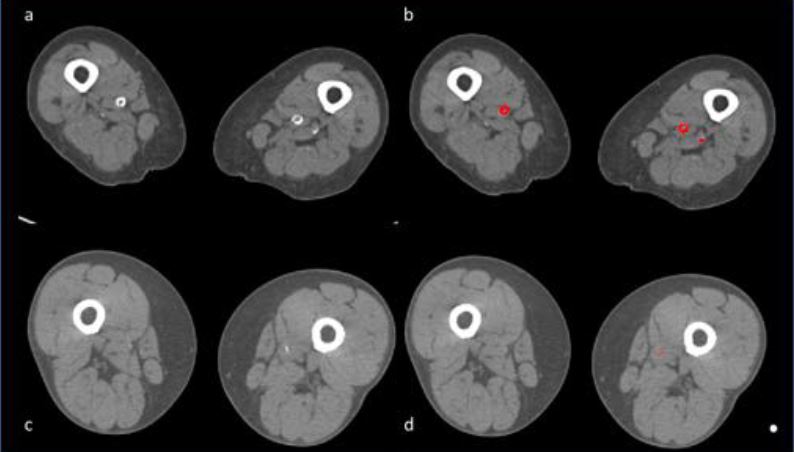Osteoporosis y aterosclerosis en nonagenarios frágiles institucionalizados:
relación con la cantidad y la calidad muscular
Palabras clave:
Osteoporosis, poster, seram, aterosclerosis, nonagenarios, CAT, CAA, CAI, CAF, DMO, frágil, frágilesResumen
OBJETIVOS
Comparar el volumen de calcio vascular en aorta torácia (CAT), aorta abdominal (CAA), arterias ilíacas (CAI), arterias femorales (CAF), densidad mineral ósea (DMO) de vertebras lumbares, entre sujetos ancianos frágiles y no frágiles. Estudiar las posibles asociaciones entre el volumen de calcifiación vascular total y en distintos segmentos arteriales, DMO y variables de cantidad y calidad muscular sujetos ancianos frágiles y no frágiles.
INTRODUCCIÓN
El término fragilidad define un síndrome asociado con la edad que se caracteriza por la aparición de pérdida de movilidad, mayor riesgo de caídas, aumento en frecuencia y duración hospitalización de pacientes ancianos , e incluso muerte. [1-4]. Este síndrome presenta una fuerte asociación con aparición de sarcopenia, teniendo así mismo relación con enfermedad cardiovascular subclínica [5], y osteoporosis [6]. Si bien algunos autores consideran a la aterosclerosis como parte del proceso de envejecimiento [7] , la presencia de aterosclerosis calcificada ha sido asociada con un mayor riesgo de mortalidad, dependiendo la fuerza de esta asociación con los lechos vasculares afectadas [8]. Existen trabajos que muestran una clara asociación entre presencia de calcificación de las arterias coronarias o calcificación de la aorta torácica (CAT) detectada en radiografías de tórax y tomografía axial computerizada (TC) con un aumento de riesgo de enfermedad cardiovascular [9].
Descargas
Citas
Guralnik JM, Ferrucci L, Simonsick EM, et al. Lower-extremity function in persons over the age of 70 years as a predictor of subsequent disability. N Engl J Med 1995;332:556-562.
Rodríguez Mañas L, Féart C, Mann G et al, on behalf of the FOD-CC group. Searching for an operational definition of frailty: A Delphi method based consensus statement. The frailty operative definition-consensus conference project. J Gerontol A Biol Sci Med Sci 2012; 68:62–67
Cadore EL, Casas-Herrero A, Zambom-Ferraresi F, et al. Multicomponent exercises including muscle power training enhance muscle mass, power output, and functional outcomes in institutionalized frail nonagenarians. 2014;36(2):773-85.
Idoate F, Cadore EL, Casas-Herrero A, et al. Adipose tissue compartments, muscle mass, muscle fat infiltration, and coronary calcium in institutionalized frail nonagenarians. Eur Radiol. 2015;25(7):2163-75.
Fried LP, Tangen CM, Waltson J et al .Cardiovascular health study collaborative research group. Frailty in older adults: evidence for a phenotype. J Gerontol A Biol Sci Med Sci 2001;56:146–155
Edwards MH, Dennison EM, Aihie Sayer A, et al. Osteoporosis and sarcopenia in older age. Bone 2015;80:126-30.
Chen ME, Kawakubo M, Colleti PM, et al. Effect of age on aortic atherosclerosis. Journal of Geriatric Cardiology 2013;10:135−140
Allison MA, Hsi S, Wassel CL, Morgan C, Ix JH, et al. Calcified Atherosclerosis in Different Vascular Beds and the Risk of Mortality. Arteriosclerosis, Thrombosis, and Vascular Biology 2012; 32:140–146.
Budoff MJ, NAsir K, Katz R, et al. Thoracic Aortic Calcification and Coronary Heart Disease Events: the Multi-Ethnic Study of Atherosclerosis (MESA) Atherosclerosis. 2011; 215(1):196–202.
Chuang ML, Massaro JM, Levitzky YS et al. Prevalence and Distribution of Abdominal Aortic Calcium by Sex and Age-Group in a Community-based Cohort (From The Framingham Heart Study). Am J Cardiol . 2012; 110(6): 891–896.
Wilson PWF, Kaupilla L, O’Donnell CJ, Kiel DP, Hannan M, Polak JM et al. Abdominal aortic calcific deposits are an important predictor of vascular morbidity and mortality. Circulation 2001;103:1529–1534.
van Staa TP, Dennison EM, Leufkens HG, Cooper C. Epidemiology of fractures in England and Wales. Bone 2001;29:517–22.
Hernlund E, Svedbom A, Ivergard M, Compston J, Cooper C, Stenmark J, et al. Osteoporosis in the European Union: medical management, epidemiology and economic burden. A report prepared in collaboration with the International Osteoporosis Foundation (IOF) and the European Federation of Pharmaceutical Industry Associations (EFPIA). Arch Osteoporos 2013;8:136.
Edwards M, Gregson C, Patel H, Jameson K, Harvey N, Sayer AA, et al. Muscle size, strength and physical performance and their associations with bone structure in the Hertfordshire Cohort Study. J Bone Miner Res 2013;28(11):2295–304.
Szulc P, Blackwell T, Kiel DP, Schousboe JT, et al; Study of Osteoporotic Fractures (SOF) Research Group. Abdominal aortic calcification and risk of fracture among older women - The SOF study. Bone. 2015;81:16-23
Issever AS(1), Kentenich M, Köhlitz T, Diederichs G, Zimmermann E. Osteoporosis and atherosclerosis: a post-mortem MDCT study of an elderly cohort. Eur Radiol. 2013;23(10):2823-9.
Casas-Herrero A, Cadore EL, Zambom-Ferraresi F, et al. Functional capacity, muscle fat infiltration, power output, and cognitive impairment in institutionalized frail oldest old. Rejuvenation Res. 2013;16(5):396-403.
Fried LP, Tangen CM, Waltson J, et al. Cardiovascular Health Study Collaborative Research Group. Frailty in older adults: evidence for a phenotype. J Gerontol A Biol Sci Med Sci 2012;56:146-155
Baracos VE, Reiman T, Mourtzakis M, et al . Body composition in patients with non-small cell lung cáncer: a contemporary view of cáncer cachexia with the use of computed tomography image analysis. Am J Clin Nutr 2010;91:1133-1137
Shen W, Punyanitya M, Wang Z, et al.Total body skeletal muscle and adipose tissue volumes: estimation from a single abdominal cross-sectional image. J Appl Physiol 2004;97: 2333–2339
Demerath EW, Sun SS, Rogers N et al.Anatomical patterning of visceral adipose tissue: race, sex, and age variation. Obesity (Silver Spring) 2007;15:2984–2993
Lee SJ, Janssen I, Heymsfield SB, Ross R (2004) Relation between whole-body and regional measures of human skeletal muscle. Am J Clin Nutr 2004; 80:1215-21.
Eisen A, Tenenbaum A, Koren-Morag N et al (2008). Calcification of the thoracic aorta as detected by spiral computed tomography among stable angina pectoris patients: association with cardiovascular events and death. Circulation 2008;118(13):1328-34.
Pickhardt PJ, Pooler DB, MD; Lauder T et al.Opportunistic Screening for Osteoporosis Using Abdominal Computed Tomography Scans Obtained for Other Indications. Ann Intern Med. 2013;158:588-595.
Jensky NE, Criqui MH, Wright CM et al. The association between abdominal body composition and vascular calcification. Obesity (Silver Spring). 2011 Dec;19(12):2418-24.


